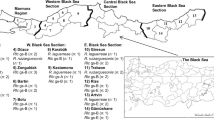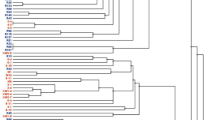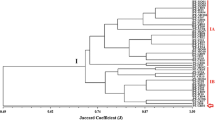Abstract
In this study, we obtained a total of 60 rhizobial isolates from root nodules of Vicia faba L. (n = 30) and Pisum sativum L. (n = 30) grown in the Central Black Sea region of Turkey. The 16S rDNA PCR-RFLP analysis with enzymes CfoI, HinfI, NdeII and MspI revealed a single pattern. Moreover, nucleotide sequence phylogenies based on both the 16S rDNA and recA suggested that these isolates belonged to Rhizobium leguminosarum. Phylogenetic analysis showed that some of our V. faba L.-originated isolates were closely related, indicating molecular evidence for the selection of some special R. leguminosarum bv. viciae isolates by V. faba L., as suggested in previous studies. Network analysis based on recA sequences revealed a common evolutionary history for Turkish, European, North and South American, and Jordanian R. leguminosarum bv. viciae isolates. We isolated four haplotypes using nodA and nifH nucleotide sequence data, i.e. four types of sym plasmids. Two of these types were common to rhizobial isolates from both V. faba L. and P. sativum L., indicating that nodulation factors may not be the mechanism for selection of the special R. leguminosarum bv. viciae populations by V. faba L.






Similar content being viewed by others
References
Abbo S, Gopher A, Rubin B, Lev-Yadun S (2005) On the origin of Near Eastern founder crops and the ‘dump-heap hypothesis’. Genet Resour Crop Ev 52:491–495. doi:10.1007/s10722-004-7069-x
Álvarez-Martínez ER, Valverde A, Ramírez-Bahena MH, García-Fraile P, Tejedor C, Mateos PF, Santillana N, Zúñiga D, Peix A, Velázquez E (2009) The analysis of core and symbiotic genes of rhizobia nodulating Vicia from diVerent continents reveals their common phylogenetic origin and suggests the distribution of Rhizobium leguminosarum strains together with Vicia seeds. Arch Microbiol 191:659–668. doi:10.1007/s00203-009-0495-6
Amarger N, Macheret V, Laguerre G (1997) Rhizobium gallicum sp. nov. and Rhizobium giardinii sp. nov., from Phaseolus vulgaris nodules. Int J Syst Bacteriol 47:996–1006. doi:10.1099/00207713-47-4-996
Bandelt HJ, Foster P, Rohl A (1999) Median-joining networks for inferring intraspecific phylogenies. Mol Biol Evol 16:37–48
Cassens I, Mardulyn P, Milinkovitch M (2005) Evaluating intraspecific ‘network’ construction methods using simulated sequence data: do existing algorithms outperform the global maximum parsimony approach? Syst Biol 54:363–372
Chen WX, Tan ZY, Gao JL, Li Y, Wang ET (1997) Rhizobium hainanense sp. nov., isolated from tropical legumes Int J Syst Bacteriol 47(3):870–873. doi:10.1099/00207713-47-3-870
Chetkova SA, Tikhonovich IA (1986) Isolation and investigation of Rhizobium leguminosarum strains effective on peas of Afghan origin. Microbiology 55:143–147
Cousin R (1997) Peas (Pisum sativum L.). Field Crop Res 53:111–130. doi:10.1016/S0378-4290(97)00026-9
Cubero JI (1973) Evolutionary trends in Vicia faba. Theor Appl Genet 43:59–65. doi:10.1007/BF00274958
Cubero JI (1974) On the evolution of Vicia faba L. Theor Appl Genet 45:47–51. doi:10.1007/BF00283475
Davis EO, Evans IJ, Johnston AWB (1988) Identification of nodX, a gene that allows the Rhizobium leguminosarum biovar viciae strain TOM to nodulate Afghanistan peas. Mol Gen Genet 212:531–535
De Meyer SE, Willems A (2011) Genetic diversity of rhizobia associated with indigenous legumes in different regions of Flanders (Belgium). Soil Biol Biochem 43(12):2384–2396. doi:10.1016/j.soilbio.2011.08.005
Ditta G, Virts E, Palomares A, Kim CH (1987) The nifA Gene of Rhizobium meliloti is Oxygen Regulated. J Bacteriol 169(7):3217–3223
Duc G, Bao S, Baum M, Redden B, Saiki M, Suso MJ, Vishniakova M, Zong X (2010) Diversity maintenance and use of Vicia faba L. genetic resources. Field Crop Res 115:270–278. doi:10.1016/j.fcr.2008.10.003
Efron B (1982) The jackknife, the bootstrap and other resampling plans. CBMS-NSF Regional Conference Series in Applied Mathematics, Monograph 38, SIAM, Philadelphia
Felsenstein J (1985) Confidence limits on phylogenies: an approach using the bootstrap. Evolution 39:783–791
Felsenstein J (2004) PHILIP (Phylogeny Inference Package) version 3.6. Distributed by the author. Department of Genome Science, University of Washington, Seattle.
Gaunt MW, Turner SL, Rigotier-Gois L, Lloyd-Macgilp SA, Young JPW (2001) Phylogenies of atpD and recA support the small subunit rRNA-based classification of rhizobia. Int J Syst Evol Micr 51:2037–2048. doi:10.1099/00207713-51-6-2037
Gonzalez V, Bustos P, Ramirez-Romero MA, Medrano-Soto A, Salgado H, Hernandez-Gonzalez I, Hernandez-Celis JC, Quintero V, Moreno-Hagelsieb G, Girard L, Rodriguez O, Flores M, Cevallos MA, Collado-Vides J, Romero D, Davila G (2003) The mosaic structure of the symbiotic plasmid of Rhizobium etli CFN42 and its relation to other symbiotic genome compartments. Genome Biol 4(6):R36. doi:10.1186/gb-2003-4-6-r36
Gu CT, Wang ET, Sui XH, Chen WF, Chen WX (2007) Diversity and geographical distribution of rhizobia associated with Lespedeza spp. in temperate and subtropical regions of China. Arch Microbiol 188(4):355–365. doi:10.1007/s00203-007-0256-3
Guindon S, Gascuel O (2003) A simple, fast and accurate algorithm to estimate large phylogenies by maximum likelihood. Syst Biol 52(5):696–704. doi:10.1080/10635150390235520
Gurkanli CT, Ozkoc I, Gunduz I (2012) Genetic diversity of rhizobia nodulating common bean (Phaseolus vulgaris L.) in the Central Black Sea region of Turkey. Ann Mic. doı:10.1007/s13213-012-0551-3
Hall TA (1999) BioEdit: a user-friendly biological sequence alignment editor and analysis program for Windows 95/98/NT. Nucleic Acids Symposium Serie 41:95–98
Han TX, Wang ET, Han LL, Chen WF, Sui XH, Chen WX (2008a) Molecular diversity and phylogeny of rhizobia associated with wild legumes native to Xinjiang, China. Syst Appl Microbiol 31:287–301. doi:10.1016/j.syapm.2008.04.004
Han TX, Wang ET, Wu LJ, Chen WF, Gu JG, Gu CT, Tian CF, Chen WX (2008b) Rhizobium multihospitium sp. nov., isolated from multiple legume species native of Xinjiang, China. Int J Syst Evol Microbiol 58(7):1693–1699. doi:10.1099/ijs.0.65568-0
Haukka K, Lindstrom K, Young JPW (1998) Three phylogenetic groups of nodA and nifH genes in Sinorhizobium and Mesorhizobium isolates from Leguminous trees growing in Africa and Latin America. Appl Environ Microbiol 64(2):419–426
Holl FB (1975) Host plant control of the inheritance of dinitrogen fixation in the Pisum-Rhizobium symbiosis. Euphytica 24:767–770. doi:10.1007/BF00132916
Hou BC, Wang ET, Li Y, Jia RZ, Chen WF, Man CX, Sui XH, Chen WX (2009) Rhizobial resource associated with epidemic Legumes in Tibet. Microbial Ecol 57:69–81. doi:10.1007/s00248-008-9397-4
Hynes MF, O’Connell MPO (1990) Host plant effect on competition among strains of Rhizobium leguminosarum. Can J Microbiol 36:864–869. doi:10.1139/m90-150
Jensen ES, Sorensen H, Engrild KC (1986) Danish Rhizobium leguminosarum strains nodulating Afghanistan peas (Pisum sativum). Physiol Plant 66:46–48
Kan FL, Chen ZY, Wang ET, Tian CF, Sui XH, Chen WX (2007) Characterization of symbiotic and endophytic bacteria isolated from root nodules of herbaceous legumes grown in Qinghai-Tibet plateau and in other zones of China. Arch Microbiol 188:103–115. doi:10.1007/s00203-007-0211-3
Kozik A, Heidstra R, Horvath B, Kulikova O, Tikhonovich I, Ellis THN, van Kammen A, Lie TA, Bisseling T (1995) Pea lines carrying sym1 or sym2 can be nodulated by Rhizobium strains containing nodX; sym1 and sym2 are allelic. Plant Sci 108:41–49
Kuykendall LD, Young JM, Martinez-Romero E, Kerr A, Sawada H (2005) Genus I. Rhizobium. In: Garrity GM (ed) Bergey’s Manual of Systematic Bacteriology, Part C The Alpha-, Beta-, Delta-, and Epsilonproteobacteria. Springer, New York, pp 325–340
Kwon SW, Park JY, Kim JS, Kang JW, Cho YH, Lim CK, Parker MA, Lee GM (2005) Phylogenetic analysis of the genera Bradyrhizobium, Mesorhizobium, Rhizobium and Sinorhizobium on the basis of 16S rRNA gene and internally transcribed spacer region sequences. Int J Sys Evol Microbiol 55:263–270. doi:10.1099/ijs.0.63097-0
Ladizinsky G (1975) On the origin of the broad bean Vicia faba L. Israel J Bot 24:80–88
Laguerre G, Allard M, Revoy F, Amarger N (1994) Rapid Identification of Rhizobia by Restriction Fragment Lenght Polymorphism Analysis of PCR-Amplified 16S rRNA Genes. Appl Environ Microbiol 60(1):56–63
Laguerre G, Nour SM, Macheret V, Sanjuan J, Drouin P, Amarger N (2001) Classification of rhizobia based on nifH gene analysis reveals a close phylogenetic relationship among Phaseolus vulgaris symbionts. Microbiology 147:981–993
Laguerre G, Louvrier P, Allard MR, Amarger N (2003) Compatibility of Rhizobial genotypes within natural populations of Rhizobium leguminosarum biovar viciae for nodulation of host legumes. Appl Environ Microbiol 69(4):2276–2283. doi:10.1128/AEM.69.4.2276-2283.2003
Laranjo M, Alexandre A, Rivas R, Velazquez E, Young JP, Oliveira S (2008) Chickpea rhizobia symbiosis genes are highly conserved across multiple Mesorhizobium species. FEMS Microbiol Ecol 66:391–400. doi:10.1111/j.1574-6941-2008.00584.x
Lie TA (1978) Symbiotic specialization in pea plants: the requirement of specific Rhizobium strains for peas from Afghanistan. Ann Appl Biol 88:462–465. doi:10.1111/j.1744-7348.1978.tb00743.x
Lopez-Lopez A, Rogel MA, Ormeno-Orrillo E, Martinez-Romero J, Martinez-Romero E (2010) Phaseolus vulgaris seed-borne endophytic community with novel bacterial species such as Rhizobium endophyticum sp. Nov. Syst Appl Microbiol 33(6):322–327. doi:10.1016/j.soilbio.2003.10.025
Ma SW, Iyer VN (1990) New field isolates of Rhizobium leguminosarum bivar viciae that nodulate the primitive pea cultivar Afghanistan in addition to modern cultivars. Appl Environ Microb 56(7):2206–2212
Martens M, Delaere M, Coopman R, De Vos P, Gillis M, Willems A (2007) Multilocus sequence analysis of Ensifer and related taxa. Int J Syst Evol Microbiol 57(3):489–503. doi:10.1099/ijs.0.64344-0
Maxted N (1995) An ecogeographical study of Vicia subgenus Vicia. Systematic and Ecogeographical Studies on Crop Genepools, vol 8. IPGRI, Rome
Mazur A, Stasiak G, Wielbo J, Kubik-Komar A, Marek-Kozaczuk M, Skorupska A (2011) Intragenomic diversity of Rhizobium leguminosarum bv. trifolii clover nodule isolates. BMC Microbiol 11(1):123
Moschetti G, Peluso AL, Protopapa A, Anastasio M, Pepe O, Defez R (2005) Use of nodulation pattern, stress tolerance, nodC gene amplification, RAPD-PCR and RFLP-16S rDNA analysis to discriminate genotypes of Rhizobium leguminosarum biovar viciae. Syst Appl Microbiol 28:619–631. doi:10.1016/j.syapm.2005.03.009
Muratova VS (1931) Common beans (Vicia faba L.). Bull Appl Bot Genet Pl Breed Suppl 50:1–298
Mutch LA, Tamimi SM, Young JPW (2003) Genotypic characterisation of rhizobia nodulating Vicia faba from the soils of Jordan: a comparison with UK isolates. Soil Biol Biochem 35:709–714. doi:10.1016/S0038-0717(03)00088-9
Ovtsyna AO, Rademaker GJ, Esser E, Weinman J, Rolfe BG, Tikhonovich IA, Lugtenberg BJJ, Thomas-Oates JE, Spaink HP (1999) Comparison of Characteristics of the nodX Genes from Various Rhizobium leguminosarum Strains. Mol Plant Microbe In 12(3):252–258. doi:10.1094/MPMI.1999.12.3.252
Pollack RA, Findlay L, Mondschein W, Modesto RR (2002) Laboratory Exercises in Microbiology. Wiley, New York
Posada D (2008) jModel test: phylogenetic model averaging. Mol Biol Evol 25:1253–1256. doi:10.1093/molbev/msn083
Posada D, Crandall KA (2001) Intraspecific phylogenetics: trees grafting into networks. Trends Ecol Evol 16:37–45
Rahi P, Kapoor R, Young JPW, Gulati A (2012) A genetic discontinutity in root-nodulating bacteria of cultivated pea in the Indian trans-Himalayas. Mol Ecol 21:145–159. doi:10.1111/j.1365-294X.2011.05368.x
Ramirez-Bahena MH, Garcia-Fraile P, Peix A, Valverde A, Rivas R, Igual JM, Mateos PF, Martinez-Molina E, Velazquez E (2008) Revision of the taxonomic status of the species Rhizobium leguminosarum (Frank 1879) Frank 1889AL, Rhizobium phaseoli Dangeard 1926AL and Rhizobium trifolii Dangeard 1926AL. R. trifolii is a later synonym of R. leguminosarum. Reclassification of the strain R. leguminosarum DSM 30132 (=NCIMB 11478) as Rhizobium pisi sp. nov. Int J Syst Evol Micr 58:2484–2490. doi:10.1099/ijs.0.65621-0
Rashid MH, Schafer H, Gonzalez J, Wink M (2012) Genetic diversity of rhizobia nodulating lentil (Lens culinaris) in Bangladesh. Syst Appl Microbiol 35(2):98–109. doi:10.1016/j.syapm.2011.11.008
Rossen L, Johnston AW, Downie JA (1984) DNA sequence of the Rhizobium leguminosarum nodulation genes nodAB and C required for root hair curling. Nucleic Acids Res 12(24):9497–9508. doi:10.1093/nar/12.24.9497
Saitou N, Nei M (1987) The Neighbor-joining Method: A new Method for Reconstructing Phylogenetic Trees. Mol Biol Evol 4(4):406–425
Santillana N, Ramirez-Bahena MH, Garcia-Fraile P, Velazquez E, Zuniga D (2008) Phylogenetic diversity based on rrn, atpD, recA genes and 16S-23S intergenic sequence analyses of Rhizobial strains isolated from Vicia faba and Pisum sativum in Peru. Arch Microbiol 189:239–247. doi:10.1007/s00203-007-0313-y
Sawada H, Ieki H, Oyaizu H, Matsumoto S (1993) Proposal for rejection of Agrobacterium tumefaciens and revised descriptions for the genus Agrobacterium and for Agrobacterium radiobacter and Agrobacterium rhizogenes. Int J Syst Bacteriol 43(4):694–702. doi:10.1099/00207713-43-4-694
Scott KF, Rolfe BG, Shine J (1983) Biological nitrogen fixation: primary structure of the Rhizobium trifolii iron protein gene. DNA 2(2):149–155. doi:10.1089/dna.1983.2.149
Shamseldin A, Muhammad ES, Sadowsky MJ, An CS (2009) Rapid identification and discrimination among Egyptian genotypes of Rhizobium leguminosarum bv. viciae and Sinorhizobium meliloti nodulating faba bean (Vicia faba L.) by analysis of nodC, ARDRA and rDNA sequemce analysis. Soil Biol Biochem 41:45–53. doi:10.1016/j.soilbio.2008.09.014
Somasegaran P, Hoben HJ (1985) Methods in Legume-Rhizobium Technology. USAID, USA
Swofford DL (1998) PAUP* Phylogenetic Analysis Using Parsimony (*and Other Methods). Version 4 beta 10. Sinauer, Sunderland
Tanno K, Willcox G (2006) The Origins of Cultivation of Cicer arietinum L. and Vicia faba L.: Early Finds From Tell el-Kerkh, North-West Syria, Late 10th Millennium B.P. Veget Hist Archaeobot 15:197–204. doi:10.1007/s00334-005-0027-5
Temizkan G, Arda N (2004) Moleküler Biyolojide Kullanılan Yöntemler. Nobel Tıp Kitabevleri, İstanbul
Thompson JD, Gibson TJ, Plewniak F, Jeanmougin F, Higgins DG (1997) The ClustalX-Windows interface: Flexible strategies for multiple sequence alignment aided by quality analysis tools. Nucleic Acids Res 25:4876–4882
Tian CF, Wang ET, Han TX, Sui XH, Chen WX (2007) Genetic diversity of rhizobia associated with Vicia faba in three ecological regions of China. Arch Microbiol 188:273–282. doi:10.1007/s00203-007-0245-6
Tian CF, Young JPW, Wang ET, Tamimi SM, Chen WX (2010) Population mixing of Rhizobium leguminosarum bv. viciae nodulating Vicia faba: the role of recombination and lateral gene transfer. FEMS Microbiol Ecol 1–14
Valverde A, Igual JM, Peix A, Cervantes E, Velazquez E (2006) Rhizobium lusitanum sp. nov. a bacterium that nodulates Phaseolus vulgaris. Int J Syst Evol Microbiol 56(11):2631–2637. doi:10.1099/ijs.064402-0
Van Berkum P, Beyene D, Vera FT, Keyser HH (1995) Variability among Rhizobium strains originating from nodules of Vicia faba. Appl Environ Microbiol 61(7):2649–2653
Van Berkum PB, Beyene D, Eardly BD (1996) Phylogenetic relationship among Rhizobium species nodulating the common bean (Phaseolus vulgaris L.). Int J Syst Bacteriol 46:240–244. doi:10.1099/00207713-46-1-240
Van Berkum P, Beyene D, Bao G, Campbell TA, Eardly BD (1998) Rhizobium mongolense sp. nov. is one of three rhizobial genotypes identified which nodulate and form nitrogen-fixing symbioses with Medicago ruthenica [(L.) Ledebour]. Int J Syst Bacteriol 48(1):13–22. doi:10.1099/00207713-48-1-13
Vincent JM (1970) A manuel for the Practical Study of the Root-Nodule Bacteria. Blackwell, Oxford
Vinuesa P, Silva C, Lorite MJ, Izaguirre-Mayoral ML, Bedmar EJ, Martinez-Romero E (2005) Molecular systematics of rhizobia based on maximum likelihood and Bayesian phylogenies inferred from rrs, atpD, recA and nifH sequences, and their use in the classification of Sesbania microsymbionts from Venezuelan wetlands. Syst Appl Microbiol 28(8):702–716. doi:10.1016/j.syapm.2005.05.007
Wang F, Wang ET, Wu LJ, Sui XH, Li Y Jr, Chen WX (2011) Rhizobium vallis sp. nov., isolated from nodules of three leguminous species. Int J Syst Evol Microbiol 61(11):2582–2588. doi:10.1099/ijs.0.026484-0
Wei GH, Wang ET, Tan ZY, Zhu ME, Chen WX (2002) Rhizobium indigoferae sp. nov. and Sinorhizobium kummerowiae sp. nov., respectively isolated from Indigofera spp. and Kummerowia stipulacea. Int J Syst Evol Microbiol 52(6):2231–2239. doi:10.1099/ijs.0.02030-0
Weisburg WG, Barns SM, Pelletier DA, Lane DJ (1991) 16S Ribosomal DNA amplification for phylogenetic study. J Bacteriol 173:697–703
Woolley S, Posada D, Crandall KA (2008) A comparison of phylogenetic network methods using computer simulation. PLoS One 3:e1913
Young JP, Crossman LC, Johnston AW, Thomson NR, Ghazoui ZF, Hull KH, Wexler M, Curson AR, Todd JD, Poole PS, Mauchline TH, East AK, Quail MA, Churcher C, Arrowsmith C, Cherevach I, Chillingworth T, Clarke K, Cronin A, Davis P, Fraser A, Hance Z, Hauser H, Jagels K, Moule S, Mungall K, Norbertczak H, Rabbinowitsch E, Sanders M, Simmonds M, Whitehead S, Parkhill J (2006) The genome of Rhizobium leguminosarum has recognizable core and accessory components. Genome Biol 7(4):R34. doi:10.1186/gb-2006-7-4-r34
Zafran-Novak J, Redzepovic S, Cetkovic H (2010) Genetic analysis of a nodA-nodD region of autochthonous strains of Rhizobium leguminosarum biovar viciae that showed effective nodulation of host plants. Period Biol 112(4):459–467
Zhang XX, Guo XW, Terefework Z, Paulin L, Cao YZ, Hu FR, Lindstrom K, Li FD (1999) Genetic diversity among rhizobial isolates from field-grown Astragalus sinicus of Southern China. Syst Appl Microbiol 22:312–320. doi:10.1016/S0723-2020(99)80078-2
Zhang RJ, Hou BC, Wang ET, Li Y Jr, Zhang XX, Chen WX (2011) Rhizobium tubonense sp. nov., isolated from root nodules of Oxytropis glabra. Int J Syst Evol Microbiol 61(3):512–517. doi:10.1099/ijs.0.020156-0
Acknowledgment
We thank Gregory T. Sullivan for editing an earler version of this manuscript.
Author information
Authors and Affiliations
Corresponding author
Rights and permissions
About this article
Cite this article
Gurkanli, C.T., Ozkoc, I. & Gunduz, I. Genetic diversity of Vicia faba L. and Pisum sativum L. nodulating rhizobia in the central Black Sea region of Turkey. Ann Microbiol 64, 99–112 (2014). https://doi.org/10.1007/s13213-013-0638-5
Received:
Accepted:
Published:
Issue Date:
DOI: https://doi.org/10.1007/s13213-013-0638-5




